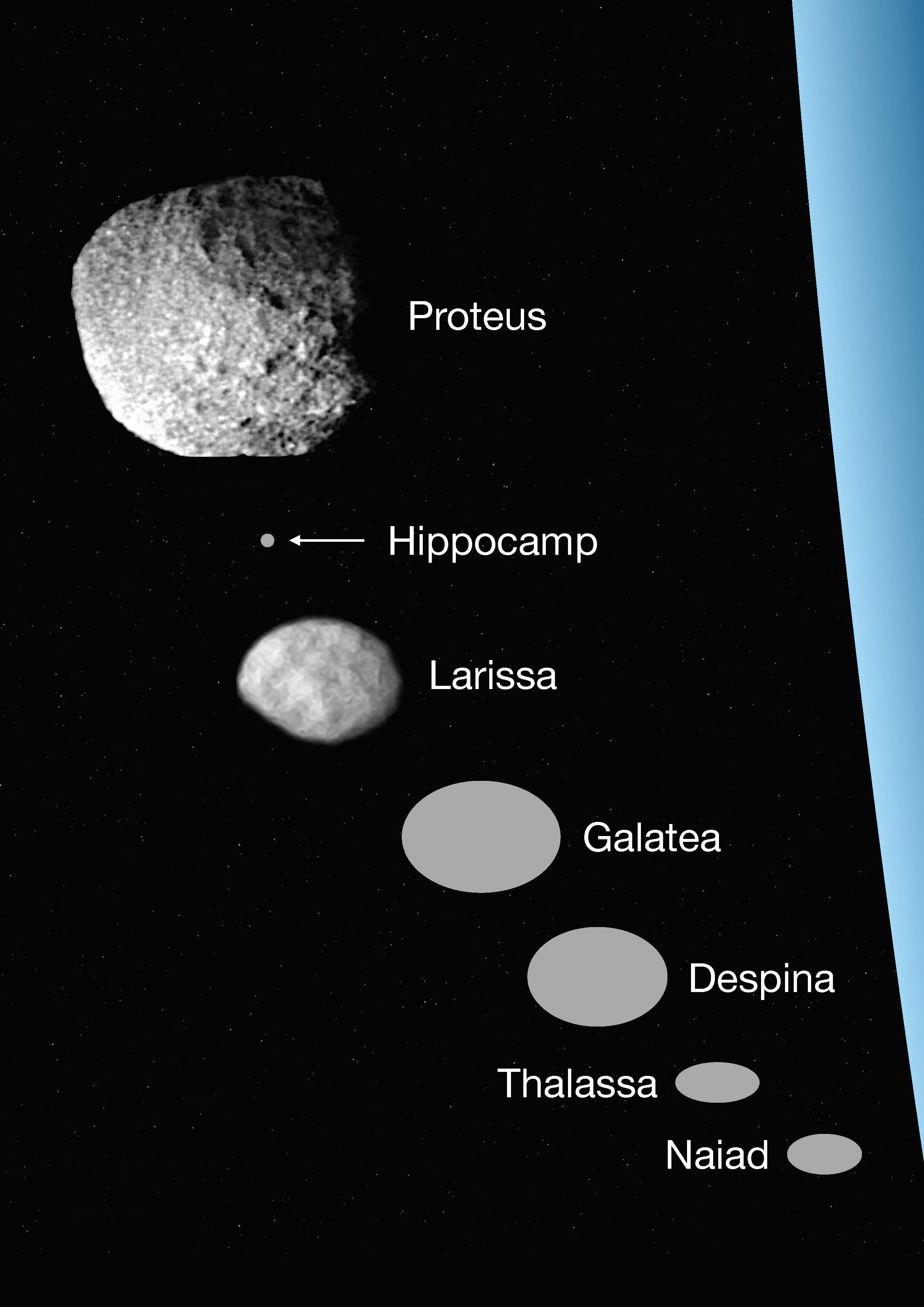Astronomers Officially Name the Newest Moon of Neptune
Scientists have discovered a tiny moon orbiting Neptune, bringing the planet's total number of known satellites to 14.
In keeping with the convention of naming Neptune's moons after water deities, the newly described world is called Hippocamp, after a mythological equine sea creature.
Hippocamp is only about 34 kilometers (21 miles) in diameter, making it the runt of the Neptunian family. It is one of seven inner moons of Neptune, a group that tightly orbits the planet roughly once every day.
 Size comparisons of Neptune's inner moons, including Hippocamp. Image: Mark R. Showalter, SETI Institute
Size comparisons of Neptune's inner moons, including Hippocamp. Image: Mark R. Showalter, SETI InstituteWhen the Voyager 2 spacecraft passed by Neptune in 1989, it discovered six moons in Neptune's inner orbit. Neptune is also orbited by seven other satellites located in more distant and irregular trajectories.
Hippocamp, the second farthest of the inner moons from Neptune, managed to stay hidden from the Voyager probe because of its dimness and suboptimal camera angles.
In 2013, Mark Showalter, a senior research scientist at the SETI (Search for Extraterrestrial Intelligence) Institute, pinpointed Hippocamp in images captured by the Hubble Space Telescope. It took years to confirm its physical and orbital details, and decide on an official name (previously the moon was known alternately as S/2004 N 1 or Neptune XIV).
Showalter and his colleagues announced the official name, and published their other findings, on Wednesday in Nature.
The researchers think that the new moon might have formed after a comet collided with Proteus, the largest of Neptune's inner moons, which is about 4,000 times the size of Hippocamp.
Hippocamp is close to Proteus, orbiting about 12,000 kilometers inside the trajectory of its hypothetical mother world. Proteus also happens to bear a giant impact crater called Pharos, which stretches at least 230 kilometers (143 miles) across its surface. Showalter and his colleagues suggest that Hippocamp could be made from broken-off debris from the Pharos event, which accumulated into a new small object.
 The earliest Hubble image of Hippocamp, taken in 2004. Image: Mark R. Showalter, SETI Institute
The earliest Hubble image of Hippocamp, taken in 2004. Image: Mark R. Showalter, SETI Institute"The discovery of tiny Hippocamp contributes to our understanding of the history of Neptune's inner system," the researchers wrote in the study. "Proteus and Hippocamp were even closer in the past because Proteus is migrating outwards owing to tidal interactions with Neptune."
"It is therefore worth exploring the possible connection between these moons," they added.
Based on the rate at which Proteus has migrated away from Neptune, the team estimates that Hippocamp is a few billion years old.
There's another layer to all this moon drama surrounding Neptune: All seven of the inner worlds were probably created by the arrival of Triton, Neptune's largest moon, several billion years ago.
Read More:Why We Should Use This Jumping Robot to Explore Neptune
Triton has an irregular retrograde orbit, meaning that it circles Neptune in the opposite direction of the planet's rotation. Scientists think this is because Triton was once a free object from the Kuiper belt, a band of icy objects like comets and asteroids located beyond the known planets. Triton became bound to Neptune when it ventured too close.
Neptune probably had a completely different set of inner moons when it captured Triton, but Triton's gravitational pull caused them to collide with each other, creating Neptune's thin rings and the seven battered moons that now orbit it.
All of these chance encounters help "illustrate the roles that collisions and orbital migration have played in shaping the Neptune system that we see today," Showalter's team concluded.
Update: An earlier headline of this article described Hippocamp as "a New Moon Orbiting Neptune." Since Hippocamp was first detected in 2013, the headline and article have been updated to avoid any confusion.
Get six of our favorite Motherboard stories every dayby signing up for our newsletter.